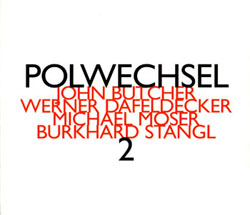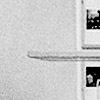| |
POLWECHSEL 2

__________________________________
__________________________________

__________________________________
Bill Meyer Polwechsel's music is not about tunes but textures; it resonates with
the grainy abrasion of bows against strings, the bristling static of electronics,
the faint dampness of air sucked through a saxophone reed.
Over the past three or four decades these sounds have become common currency
in free improvised music and the spontaneously layered piece "Falb"
proves that Polwechsel are well versed in such methods. But Michael Moser
and Werner Dafeldecker also compose with these materials. Their pieces
move deliberately from one sound field to the next, mapping and shaping
each with a surveyor's precision and a sculptor's sense of form. They
pay special attention to the points where electronic and acoustic sonorities
overlap. Butcher's breathy rasps and Stangl's rumbling electric guitar
feedback blend with Moser and Dafeldecker's bowed low strings and the
crackles and drones that issue from the latter man's little black boxes.
The four tracks on this CD all inhabit a very narrow dynamic range, pieces
develop gradually through accumulation rather than contrast. They reward
intense listening, especially on headphones, which reveals the music's
subtle details.
__________________________________
Peter Niklas Wilson Die Firma Hat Hut führt sie in ihrer hat [now] ART-Reihe, die der
neuen komponierten Musik vorbehalten ist, neben Feldman, Cage, Scelsi.
Drei der vier Stücke auf der zweiten CD des Polwechsel-Quartetts
sind als Kompositionen Einzelner ausgewiesen. Und doch ist dies Musik,
die für meine Ohren von der Sensibilität vier erfahrener Improvisatoren
lebt, Improvisatoren freilich, die sich in dieser Sensibilität für
den Moment, für Nuancen und Innenbewegungen des Klangs jenseits des
Notierbaren durch globalere oder genauere Absprachen und Vorgaben nicht
behindert fühlen (was beim Klangforum Wien-Mitglied Michael Moser
vielleicht weniger überraschend ist als beim britischen Saxophonisten
John Butcher, der Radu Malfattis Platz bei Polwechsel eingenommen hat).
Sicher: dies ist Musik von Improvisatoren, in die unverkennbar die Erfahrungen
des Feldman-, des Scelsi- und Lachenmann-Hörens eingegangen ist (beim
Endlos- Tripel-Glissando von Michael Mosers Tatoo mag man sich an Alvin
Lucier erinnert fühlen).
Musik, die Peter-Brötzmann- oder Cecil- Taylor-Begeisterte vermutlich
ratlos zurücklassen wird. Musik von Improvisatoren, die erkannt haben,
dass in der Zurücknahme, im Detail ebensoviel Kraft liegt, wie im
dramatischen Espressivo. Und die, bei aller Genauigkeit des Hantierens
mit subtilsten Geräusch- und Klang-Nuancen, nicht ins weihevolle
Zelebrieren lebloser Pianissimo-Klanginseln verfallen, wie es in der Neuen
Musik heute oft genug geschieht.
__________________________________
There is a branch of new music called Noise. I don’t propose to
pursue a connection which is really more a term of convenience. I mention
it only as a superficial and possibly even harmful suggestion at categorization.
I wish there were an term to describe an impasse of the fingertips corresponding
to tongue-tied. Be that as it may, I think I can make a few illustrative
statements without fear of harming the delicate balance in these two releases
between indeterminacy, strategy, and hair-fine precision. First, one does
not attempt to operate at this extreme distance from convention with other
than masterful, like-minded players; second, Polwechsel 2 is the more
austere and challenging program. In both Polwechsel and Polwechsel 2,
Werner Dafeldecker plays the larger part, not as performer but rather
as composer of Nord, Ost and Sudwest (Polwechsel), Hyogo and Toaster (Polwechsel
2). Given the ensemble’s supremely abstract character, one notes
with interest that Michael Moser’s NNO-Fernaumoos (Polwechsel) and
Tatoo [sic] (Polwechsel 2) seem the more musically coherent compositions,
with the latter’s nervous enegies in keeping with tattoo’s
definition: raising an alarm by means of a rapid drumbeat, etc. I do not
intend for a suggestion of coherence to imply superiority. However "incomprehensible"
the particular moment or event, the thing that most impresses about Polwechsel
as an ensemble is the sense it conveys of knowing exactly what it’s
doing and where it’s headed. If Dafeldecker’s five compositions
play relative to Moser’s two closer to noise (there, I said it!),
rest assured, it’s no accident. Falb of Polwechsel 2 is a group
project. To return to what I’ve been saying about Uehlinger’s
judgment and mission, this is the kind of thing any assemblage of overweening
weenies feel they can pull off. All one needs do is grunt, scratch and
squeak. I think not. To understand what Polwechsel accomplishes (in either
combination of players), one has to hear these discs. Not, however, for
hum-along types.
__________________________________
/..
|